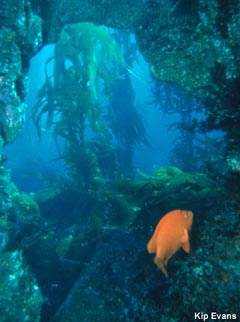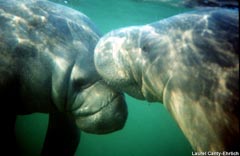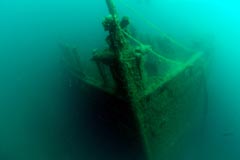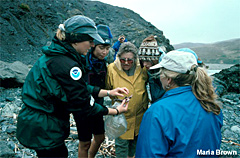|
|
The Office of National Marine Sanctuaries, part of NOAA’s National Ocean Service (NOS), manages specially designated areas of the nation’s oceans and Great Lakes that contain unique habitats; threatened and endangered species; and historic, archeological, recreational, and esthetic resources. Thirteen national marine sanctuaries and one marine national monument are part of this program, including:
Additionally, on June 15, 2006, President Bush signed a proclamation that created the Papahanaumokuakea Marine National Monument. The monument is managed by NOAA and the Department of the Interior's U.S. Fish and Wildlife Service, in close coordination with the State of Hawaii.
The Office of National Marine Sanctuaries was created by the Marine Protection, Research and Sanctuaries Act of 1972. This act authorizes the Secretary of Commerce to designate and manage areas of the marine environment with special national significance due to their conservation, recreational, ecological, historical, scientific, cultural, archeological, educational, or esthetic qualities as national marine sanctuaries. The Act also directs the Secretary to facilitate all public and private uses of those resources that are compatible with the primary objective of resource protection. Amendments to the Act in 1980, 1984, 1988, 1992, 1996, and 2000 have modified the process of how sites are designated, and have given the Secretary the authority to issue special use permits and enhance enforcement activities. The legislative history (pdf, 40Kb) and a program timeline since 1972 are available on the National Marine Sanctuary Program Web site.
Because sanctuaries are formally designated marine protected areas (MPAs), they are focal points of conservation efforts. Coral reefs, found in five sanctuaries, are closely monitored as part of NOS’s role on the U.S. Coral Reef Task Force and its National Action Plan to Conserve Coral Reefs. Some sanctuaries also are subject to special management provisions and restoration efforts such as those in the Florida Keys. NOS also works to strengthen the management, protection, and conservation of national marine sanctuaries by revising individual sanctuary management plans regularly. Sanctuary staff also conduct education programs that includes field trips, school presentations, posters, brochures, and videos. The sanctuary system contains living classrooms and laboratories for students and marine scientists. Extensive research and monitoring efforts are carried out by NOAA scientists and supported by many partners including federal, state, and local government agencies; academic institutions; and nongovernmental organizations. The System-Wide Monitoring Program (SWiM) enables sanctuary staff to develop effective ecosystem-based monitoring programs by providing a strategy for reporting the status and trends of protected resources and activities that affect them. The program includes tailored monitoring at the local (sanctuary) level to track natural resources and human uses (allowable and prohibited) as they affect water, habitat, and living resource quality. In addition, marine scientists, supported by NOAA, are sailing on voyages of discovery to explore the hidden mysteries within the nation's sanctuary system. Expeditions have occurred in the West Coast sanctuaries, southeast and Gulf of Mexico sanctuaries, the Monitor sanctuary, and the Thunder Bay sanctuary in the Great Lakes. NOAA’s Coastal and Ocean Resource Economics Program (CORE) helps sanctuary managers address socioeconomic issues by linking economics with the environment. CORE has been involved in studies of the Florida Keys and Channel Islands national marine sanctuaries where marine reserves (areas of restricted use) are proposed within a sanctuary.
In years past, thousands of people have volunteered their time to preserve our national sanctuary system. Volunteers come with a wealth of enthusiasm, experience, and in some cases, the greatest knowledge about their community sanctuary. By applying these talents toward education, monitoring and resource protection goals, volunteers help the Office of National Marine Sanctuaries fulfill its management responsibilities. In coming years, the National Marine Sanctuary Program will continue striving for an even broader volunteer program to better protect and promote the nation’s ocean and Great Lakes treasures.
Sanctuary advisory councils were formed to better involve and develop a stronger stewardship ethic among sanctuary communities. A sanctuary advisory council is a community-based advisory group consisting of representatives from various user groups, government agencies, and the public at large. The role of the council is to provide advice to the sanctuary manager on the designation and/or operation of a national marine sanctuary. Members of the councils come from a broad cross-section of the communities that lie adjacent to sanctuaries.
Friends groups assist the Office of National Marine Sanctuaries with education and outreach programs through fundraising activities. The National Marine Sanctuary Foundation assists on a national basis, while five local friends groups support education and outreach programs at specific national marine sanctuaries. Friends groups are located at Channel Islands, Florida Keys, Gulf of the Farallones, Monterey Bay, and Olympic Coast national marine sanctuaries.
(top)
|
|
|||||||||||||||||||||||||||||
- NOS Program Offices
- Center for Operational Oceanographic Products and Services
- National Centers for Coastal Ocean Science
- NOAA Coastal Services Center
- National Geodetic Survey
- Office of Coast Survey
- Office of National Marine Sanctuaries
- Office of Ocean and Coastal Resource Management
- Office of Response and Restoration

Revised August 18, 2008
| Questions, Comments? Contact Us | Report
Error | Disclaimer | About
the Site | User Survey
National Oceanic and Atmospheric
Administration | U.S.
Department of Commerce | USA.gov
http://oceanservice.noaa.gov/topics/oceans/nms/welcome.html





